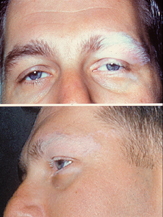
Photo from wikipedia
INTRODUCTION The reported prevalence of optic disc drusen (ODD) ranges from 0.3–2.4% in the normal population [1]. ODD can be visible or buried and this feature may partly explain the… Click to show full abstract
INTRODUCTION The reported prevalence of optic disc drusen (ODD) ranges from 0.3–2.4% in the normal population [1]. ODD can be visible or buried and this feature may partly explain the variation in prevalence data [1]. Furthermore, the assessment technique can contribute to the rate at which ODD are identified; autofluorescence (AF), OCT, B-scans, and histopathology are more sensitive in detecting buried ODD than clinical examination alone [1]. A recent study of ODD in the normal population involving histopathology put the prevalence of ODD at the higher end of the range at 1.8% [2]. Retinitis pigmentosa (RP) has been associated with ODD and the prevalence of ODD in an RP population ranges broadly from 3–80% [3, 4]. The higher rates in this range, however, were identified in small populations affected by the less common RP subtypes of preserved para-arteriole RPE & Usher’s syndrome [3, 5]. More recent studies of ODD in the RP population have shown rates of 2.95–3.6% [4, 5]. This retrospective study was undertaken to further investigate the prevalence of ODD using AF in an RP population.
Journal Title: Eye
Year Published: 2022
Link to full text (if available)
Share on Social Media: Sign Up to like & get
recommendations!